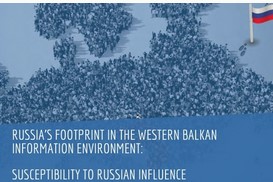Russia's Footprint in the Western Balkan Information Environment: Susceptibility to Russian Influence
Russia's Footprint in the Western Balkan Information Environment: Susceptibility to Russian Influence
Author(s): Sanda Svetoka
Subject(s): Media studies, Government/Political systems, International relations/trade, Security and defense, Political behavior, Politics and communication, EU-Approach / EU-Accession / EU-Development, ICT Information and Communications Technologies, Geopolitics
Published by: NATO Strategic Communications Centre of Excellence
Keywords: Russia; Western Balkan; information environment; Kremlin; Russian media reach in Western Balkan; Foreign policy of Russia; NATO; Misinformation;
Summary/Abstract: Since 2019 the NATO Strategic Communications Centre of Excellence (StratCom COE) has been analysing Russia’s influence in the information environment of the Western Balkans (WB). This report is the final piece of the project. It summarises the findings of the previous reports and then goes on to explore and assess the perceptions and attitudes of WB populations with regard to Russian influence activities in the WB media space. In 2020, the NATO StratCom COE published four reports investigating Russia’s tools of influence in the WBs, focusing primarily on the media landscape. Within the framework of the project Russia’s Footprint in the Western Balkan Information Environment, researchers analysed Russia’s interests in the area and its influence toolbox, and identified the vulnerabilities that make the Western Balkan countries susceptible to external manipulation. The project also identified narratives promoted by the Kremlin regarding the WBs and examined the role of local WB media in spreading those narratives. The project researchers have concluded that the Western Balkan region is not in Russia’s immediate sphere of interest; however, the Russian government considers the region a useful and easily accessible arena in which to undermine the EU and NATO. Structural vulnerabilities and societal and political divisions are exploited through cost-effective methods such as information campaigns, influencing local politicians, or even subversive activities such as hampering unity in Montenegro as it was moving toward NATO membership.
- Print-ISBN-13: 978-9934-564-42-0
- Page Count: 71
- Publication Year: 2021
- Language: English
- eBook-PDF
- Table of Content
- Introduction

